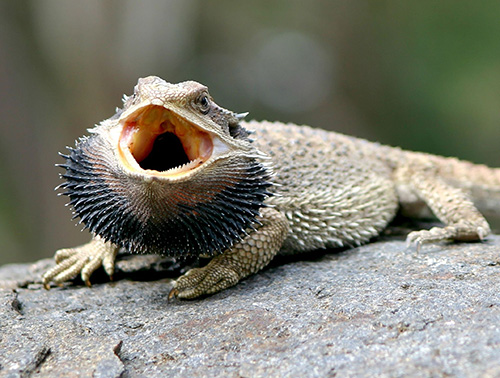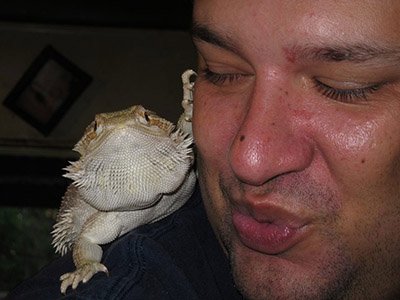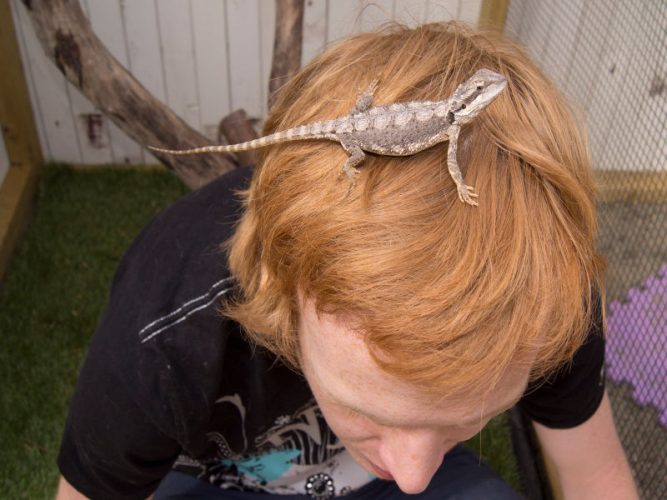Taming a bearded dragon is an art that requires patience and understanding. While these creatures are typically docile, if a bearded dragon is biting or untamed it can be challenging to care for and enjoy them. In this comprehensive guide, we delve into proven techniques from the Bearded Dragons World Community to tame your bearded dragon and prevent biting.

Jump To…
Taming a Bearded Dragon: Patience Leads to Bonding
The time it takes to tame a bearded dragon varies, depending on the lizard, its environment, and the keeper’s approach. Taming a bearded dragon often shows results within a week, but forming a strong bond takes longer. The effort you put into taming your bearded dragon is an investment in a lifelong friendship
Minimizing Stress: A Key to Successful Taming
Taming a bearded dragon can be stressful for the animal. Stress promotes illness, so avoid long periods that cause excessive stress.
To minimize this, always approach your bearded dragon calmly, they are sensitive to human emotions. When taming a bearded dragon, they may exhibit flight, fight, or freeze responses. It’s crucial to remain calm and patient during these moments.
How Bearded Dragons Respond to Threat – Humans Can Be Threats!
When responding to a threat, bearded dragons have the standard 3 options:
- Flight,
- Fight, or
- Freeze.
Bearded dragons may use all three in a single taming session depending on the animal and the situation.
Use your favorite techniques for keeping yourself calm, don’t react in a negative way. Whistle or hum a tune, whatever it takes to focus before starting taming techniques.

Safeguarding Against Bites: Preparing for the First Touch
If there’s a concern about being bitten, it’s wise to use a hand towel or gloves for protection. However, remember that covering your hand alters your scent and appearance, which your bearded dragon needs to get used to. However for safety at the beginning this is a good place to start.
Place the protective item in the enclosure beforehand, allowing your pet to become familiar with its scent, texture and appearance. This may take more than one session. Placing the glove with food or in a place the bearded dragons appears to find relaxing may speed up the process.
5 Proven Techniques for Taming a Bearded Dragon
Here are 5 tested techniques to tame your bearded dragon, gathered from the Bearded Dragons World community. For the best results in taming bearded dragons, combine multiple techniques.
- Scent Familiarization: One effective way to tame a bearded dragon is through scent familiarization. Place a cloth with your scent in their tank, and repeat this process until they become accustomed to your presence.
- Pleasurable Experiences: Gentle scrubs with a toothbrush can be enjoyable for your bearded dragon. This not only helps in grooming but also in building trust. This can be coupled with bath time.
- Food Association: Hand feeding is a great technique for taming a bearded dragon. Start by dropping food close to them and gradually hand-feed them, using tongs if necessary to prevent accidental bites.
- Easing into Touch: After scent familiarization and hand feeding, your bearded dragon should be ready for gentle touching. If concerned about biting, use a hand towel or gloves for protection.
- Providing Refuge: Ensure your bearded dragon’s habitat has hiding spots to reduce stress, especially important during the taming process. Some bearded dragons are kept in small glass sided tanks. Glass tanks have open sides providing no privacy. In addition, the bearded dragons own reflection in the glass can be a source of stress as well. Stress from a poor habitat can extend to the handler as well. Install some backgrounds and provide hiding places in the cool side of the habitat. These hiding spots and peace are important to keep stress levels down especially when pushing the boundaries when taming.

Gentle Steps: Building Trust Through Touch
Taming a bearded dragon is a process filled with patience and gradual steps. After a few days to a week of familiarizing your bearded dragon with your scent and possibly hand feeding, you should notice a significant change in its demeanor. This is the perfect time to introduce gentle physical contact, a crucial step in taming a bearded dragon.
Start Handling in a Stress-Free Environment
When you feel the time is right, choose an environment that your bearded dragon is used to. Probably its enclosure. Gently pick up your bearded dragon. Watch for signs of stress, and if you sense any discomfort, it’s best to end the session promptly. The key is to maintain a safe and secure environment for your pet, ensuring it cannot escape or injure itself.
If the opportuntity is available, offer it some of its favorite food while it is in your hand.
Use gloves if you are unsure of your bearded dragons reaction the first few times.
Frequency Over Duration: The Secret to Successful Taming
The golden rule in taming a bearded dragon is to opt for shorter, more frequent handling sessions rather than long, stressful ones. This approach helps avoid any negative associations with stress, which is detrimental to your lizard’s health. Aim for brief interactions, several times a day. Consistency over the following days and weeks will accelerate the taming process.
Progressing with Patience: Enjoying Calm Moments Together
As your bearded dragon becomes more comfortable with handling, spend tranquil time together, perhaps basking in the sunshine. Avoid introducing new activities like bathing too soon, as this might trigger fresh anxieties. Each handling session should begin and end on a positive note, ensuring a pleasant experience for both you and your pet. With time and patience, the bond you form while taming your bearded dragon will grow stronger, leading to a harmonious and fulfilling relationship.

Two Things to Avoid when Taming a Bearded Dragon
1. Don’t wear black clothes or nail polish
Black t-shirt or even black nail polish has been known to impact interactions with bearded dragons.
Some pet owners have found that wearing black can cause negative reactions from their bearded dragons whether it is a t-shirt or nail polish. While establishing the relationship it may be best to avoid black. Mind you, others have found nicely painted nails are attractive to eat!
2. Be aware of your own scent. Bearded dragons are!
Before entering a taming session be aware of all surroundings including yourself. Do you have perfume, deodorant, have you been smoking or anything else with a strong aroma that may confuse your bearded dragons senses.
Strong aromas will cover up your own scent. Bearded dragons are so good at being able to read chemical signatures that it is a part of their own communications. See more on how females can detect the quality of a male through femoral pore secretions here.
When Not to Tame a Bearded Dragon
There are certain periods when attempting to tame or handle your bearded dragon may not be advisable due to their natural behaviors and physiological states.
- During Mating Season: Hormonal Changes
Male bearded dragons, particularly when they are in their mating season, experience significant hormonal changes that can affect their behavior. These hormonal surges can lead to increased aggression, territoriality, and a general lack of interest in human interaction. At this stage bearded dragons are more focused on finding a mate and may exhibit behaviors such as heightened aggression. Attempting to tame a bearded dragon during this time can be challenging and may lead to stress for both the dragon and yourself. - During Shedding: Discomfort and Sensitivity
Shedding is another period when bearded dragons may not be receptive to taming or handling. As bearded dragons grow, they periodically shed their skin, a process that can cause discomfort and increased sensitivity. During shedding, a bearded dragon’s skin can become tight and itchy, leading to irritability.
5 Reasons a Bearded Dragon May Suddenly Start Biting
There is no denying that a bearded dragons bite can seriously hurt and if it tries, it can certainly break skin. Biting may not be the result of not being tame.
If the bearded dragon is displaying a black beard, hissing, lunging at your hand or other signs of defense or aggression it is likely protecting itself due to a perceived fear or it could be seasonal hormones. Behaviors such as staying very still or running away are also signs of fear.
If a bearded dragon starts biting when it was previously calm, consider causes such as:
- Pain and discomfort.
- Fear.
- Something recently changed that it is having difficulties with such as cage furniture moved.
- Accident, especially if it has become accustomed to your hands delivering food. Some lovely painted nails can be quite attractive potentially looking like some sort of food, especially when wearing red nail polish.
- Seasonal hormones have kicked in. For more on the signs and how to deal with a bearded dragon biting from seasonal hormones, see the post sudden aggression.
- Temperature change. An increase in temperature can change behavior. Even wild bearded dragons are very docile at low temperatures. When the temperatures increase, so does their ability to act.
Are Bearded Dragon Teeth Sharp?
Bearded dragons teeth are sharp, like serrated knives. As they grow older, their teeth wear down however they can still deliver a nasty bite.
There are also health risks with bites from bearded dragon. Treat bites quickly.
How to Tame a Bearded Dragon Conclusion
While our pet reptiles are often quite docile and amenable, it’s not always the case. There is nothing more disappointing than finding the pet that you so want to connect with doesn’t seem to want to be with you.
If your bearded dragon is biting, hissing, turning black, running away or showing other signs of distress, take it slow. If it has entered breeding season or is shedding, wait until the time has passed and they are back to normal.
When you are handling your bearded dragon make the sessions short. Dr Sharman Hoppes (2011) recommends that a successful handling session with a reptile for 2 minutes outweighs a longer session where the animal may become distressed.
Provide a habitat that has hiding spaces as well as basking.
Use all the taming bearded dragon techniques combined for a faster result
References
- Hoppes, S. (2011) Reptile Emotions. Texas A&M College of Veterinary Medicine & Biomedical Sciences






I have bought a 1 year old bearded dragon from a pet store in Nashville Tennessee about a mouth ago.I have two before him and there the sweeties.When I picked him up from the pet store I wasn’t told anything about
this dragon or feld out any paper work like I had to on my other two.When I got him home and put him in his tank he started hissing at me and trying to bite and continue to everytime i open the tank to feed him.When I got him I noticed when they handed me him he was already aggressive but I thought he was scared.So I’m going to try the things you said to do.Im not going to give up on him.Ill let you know how it goes.Thank you for the advice.